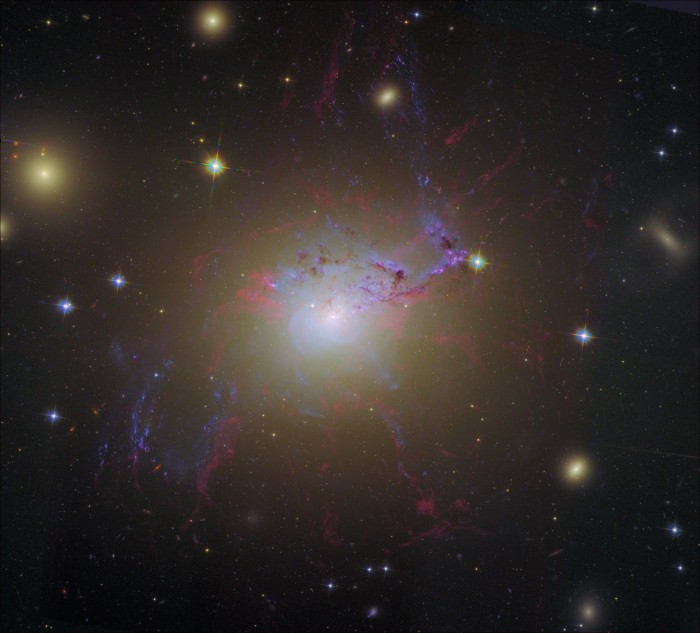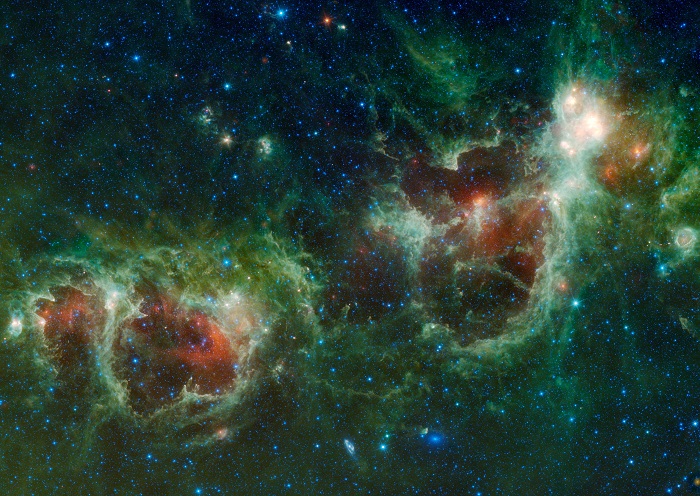Thor's Helmet
From NASA APOD:This helmet-shaped cosmic cloud with wing-like appendages is popularly called Thor’s Helmet. Heroically sized even for a Norse god, Thor’s Helmet is about 30 light-years across. In fact, the helmet is actually more like an interstellar bubble, blown as a fast wind from the bright, massive star near the bubble’s center sweeps through a surrounding molecular cloud. Known as a Wolf-Rayet star, the central star is an extremely hot giant thought to be in a brief, pre-supernova stage of evolution. Cataloged as NGC 2359, the nebula is located about 15,000 light-years away in the constellation Canis Major. The sharp image, made using broadband and narrowband filters, captures striking details of the nebula’s filamentary structures. It shows off a blue-green color from strong emission due to oxygen atoms in the glowing gas.
Credit: Star Shadows Remote Observatory and PROMPT/UNC
Why We Need the Explorers
Here’s some perspective for you. A TED talk by Brian Cox on why we should refrain from ever thinking that we know “enough”, and why explorers are paramount to the development of our species:
He cites my favorite speech by Carl Sagan, the Pale Blue Dot commencement address, as well as Humphry Davy:
Nothing is more fatal to the progress of the human mind than to presume that our views of science are ultimate, that our triumphs are complete, that there are no mysteries in nature, and that there are no new worlds to conquer.
Active Galaxy NGC 1275
From NASA APOD:Active galaxy NGC 1275 is the central, dominant member of the large and relatively nearby Perseus Cluster of Galaxies. Wild-looking at visible wavelengths, the active galaxy is also a prodigious source of x-rays and radio emission. NGC 1275 accretes matter as entire galaxies fall into it, ultimately feeding a supermassive black hole at the galaxy’s core. This color composite image, recreated from archival Hubble Space Telescope data, highlights the resulting galactic debris and filaments of glowing gas, some up to 20,000 light-years long. The filaments persist in NGC 1275, even though the turmoil of galactic collisions should destroy them. What keeps the filaments together? Observations indicate that the structures, pushed out from the galaxy’s center by the black hole’s activity, are held together by magnetic fields. Also known as Perseus A, NGC 1275 spans over 100,000 light years and lies about 230 million light years away.
Credit: Data - Hubble Legacy Archive, ESA, NASA; Processing - Al Kelly
Heart and Soul Nebulas
From NASA APOD:Is the heart and soul of our Galaxy located in Cassiopeia? Possibly not, but that is where two bright emission nebulas nicknamed Heart and Soul can be found. The Heart Nebula, officially dubbed IC 1805 and visible in the above right, has a shape in optical light reminiscent of a classical heart symbol. The above image, however, was taken in infrared light by the recently launched WISE telescope. Infrared light penetrates well inside the vast and complex bubbles created by newly formed stars in the interior of these two massive star forming regions. Studies of stars and dust like those found in the Heart and Soul Nebulas have focussed on how massive stars form and how they affect their environment. Light takes about 6,000 years to reach us from these nebulas, which together span roughly 300 light years.
Credit: NASA, JPL-Caltech, WISE Team
Symphony of Science - The Case for Mars
I love these videos! Thanks John Boswell.


